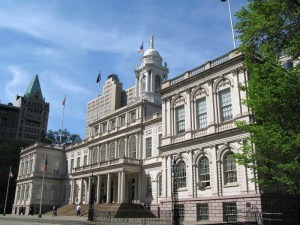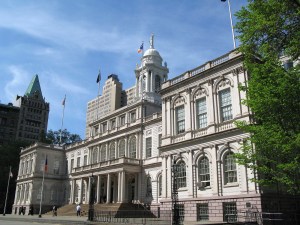Big Winners on Primary Day: de Blasio and StreetsPAC

Yesterday, New York City Democrats chose the candidate who’s campaigned as the anti-Bloomberg. But on issues of traffic safety and surface transit, Bill de Blasio, despite some wavering, has pledged to build on the current administration’s progress while tackling the unfinished business of reforming the NYPD’s approach to traffic violence. And with several City Council candidates endorsed by the newly-formed StreetsPAC winning hotly contested primaries, the results of last night’s election bode well for livable streets in NYC over the next four years. As StreetsPAC board member Eric McClure put it, “It’s clear from the results of the primary that support for safe and complete streets has gone mainstream.”
Barring an unlikely run-off victory by former comptroller Bill Thompson, de Blasio will move on to face Republican Joe Lhota, a disappointment so far on livable streets issues, as well as former Bronx Borough President Adolfo Carrion, the Independence Party candidate, and tech entrepreneur Jack Hidary, running on the Jobs and Education line.
Most of the City Council primary winners, meanwhile, are all but guaranteed election in November. These are the races in which StreetsPAC’s endorsements and volunteers made the biggest impact. In 13 of the 18 council primaries where StreetsPAC made an endorsement, the candidate won. The most significant victories came in District 38 (Sunset Park, Gowanus, and Red Hook), where challenger Carlos Menchaca knocked off incumbent Sara Gonzalez, and District 34 (South Williamsburg and parts of Bushwick and Ridgewood), where Antonio Reynoso put an end to former Brooklyn Democratic boss Vito Lopez’s bid to resuscitate his political career.
Other StreetsPAC candidates winning contested open seats include Ritchie Torres in District 15, replacing the term-limited Joel Rivera; Vanessa Gibson in District 16, replacing the term-limited Helen Foster; Mark Levine in District 7, replacing the term-limited Robert Jackson; and Costa Constantinides in District 22, replacing the term-limited Peter Vallone Jr. These elections could have an immediate impact on livable streets projects. Levine’s district, for instance, includes the western blocks of 125th Street, and as a candidate he asked NYC DOT to revive plans for Select Bus Service on the congested corridor.
“City Council members have a lot of influence over what happens in their districts and on their streets,” said StreetsPAC board member Glenn McAnanama. “This new generation of leaders like Carlos Menchaca and Antonio Reynoso in Brooklyn, Costa Constantinides in Astoria, and Richie Torres and Vanessa Gibson in the Bronx will be very important allies as the complete street revolution continues to transform New York City’s streets into safer places for all street users. A number of these new faces come from districts that had council members or opponents that were indifferent, skeptical, or outright opposed to making the changes necessary to make our streets safer and more livable. We are confident that our endorsed candidates will hit the ground running in helping to extend the gains of the past few years to a broader set of communities in our great city.”
These elections could also affect the all-important race for City Council speaker, decided by council members themselves, which has huge implications for legislation and public hearings. Menchaca’s victory, in particular, was seen as a blow to Council Member Inez Dickens’ bid for the speakership.
Dickens gained a third term yesterday by defeating Vince Morgan in one of the races where the StreetsPAC endorsee came up short. Few of those races provided quite as stark a difference between the candidates: Dickens has stonewalled pedestrian safety improvements on Adam Clayton Powell Jr. Boulevard and done nothing to advance 125th Street Select Bus Service, both projects that Morgan supports.
In three central and eastern Brooklyn districts — the 35th, 36th, and 42nd — StreetsPAC-endorsed candidates placed second in races with several candidates. (Though in District 36, where Kirsten John Foy trails Robert Cornegy by less than 100 votes, the race has yet to be called officially.) And on the Upper West Side, StreetsPAC-endorsed Mel Wymore was bested by Helen Rosenthal, who ran with some good transportation ideas but unlike Wymore didn’t make them a centerpiece of her campaign. Rosenthal is on the record supporting protected bike lanes for Columbus and Amsterdam Avenues and dedicated bus lanes for the neighborhood.
In borough-wide and citywide action, the finalists in the public advocate race, Dan Squadron and Tish James, both have livable streets bona fides from their tenures in the State Senate and City Council, respectively. Scott Stringer, a consistent voice for safer streets and one of the only NYC pols to tackle the issue of sky-high subway construction costs, topped Eliot Spitzer in the comptroller race. Ken Thompson ousted six-term incumbent Charles Hynes in the Brooklyn DA’s race (Streetsblog will be taking a closer look at the implications for traffic justice). Melinda Katz won the Queens borough president race amidst an undistinguished field. And Gale Brewer, the lone candidate who unabashedly professed support for bike-share, will succeed Stringer as Manhattan borough president.
All told, as the city prepares for the end of the administration that did more than any other to reform the cars-first status quo on NYC streets, these are some very encouraging results. They suggest that changes like bus lanes, bike lanes, and pedestrian plazas won’t just be the legacy of the billionaire mayor, but part of a lasting, far-reaching transition to more humane streets. The grassroots political muscle and awareness that StreetsPAC injected into this election cycle helped make that happen.
“Cyclists exist in a political and physical space that has been largely ignored,” said StreetsPAC board member Steve Vaccaro. “StreetsPAC aimed to make them a political force, as part of a broader livable streets movement, by reaching out to them where they are found — at bridge plazas, meetup spots like Grant’s Tomb, parked on the street, via text and in the #bikenyc Twitter feed. We had significant success with this novel physical-virtual grassroots organizing approach, and look forward to building on it.”



